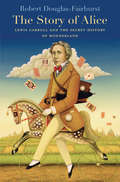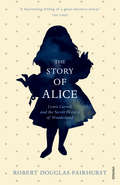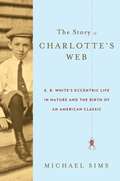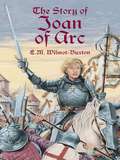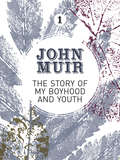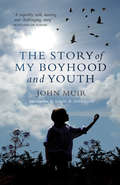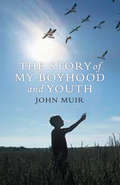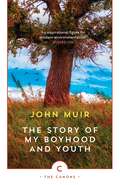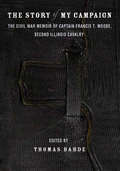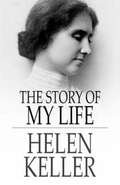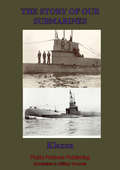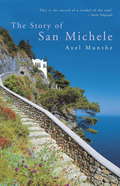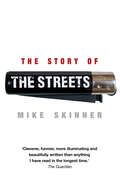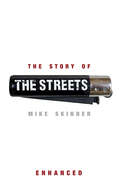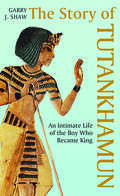- Table View
- List View
The Story of Alice: Lewis Carroll And The Secret History Of Wonderland
by Robert Douglas-FairhurstRobert Douglas-Fairhurst illuminates two entangled lives: the Oxford mathematician Charles Dodgson (Lewis Carroll) and Alice Liddell, the child for whom he invented the Alice stories. This relationship influenced Carroll’s imaginative creation of Wonderland—a sheltered world apart during the stormy transition from the Victorian to the modern era.
The Story of Alice: Lewis Carroll And The Secret History Of Wonderland
by Robert Douglas-FairhurstRobert Douglas-Fairhurst illuminates two entangled lives: the Oxford mathematician Charles Dodgson (Lewis Carroll) and Alice Liddell, the child for whom he invented the Alice stories. This relationship influenced Carroll’s imaginative creation of Wonderland—a sheltered world apart during the stormy transition from the Victorian to the modern era.
The Story of Alice: Lewis Carroll and The Secret History of Wonderland
by Robert Douglas-FairhurstSHORTLISTED FOR THE 2015 COSTA BIOGRAPHY AWARDThis is the secret history of Alice's Adventures in Wonderland.Wonderland is part of our cultural heritage. But beneath the fairy tale lies the complex history of the author and his subject. Charles Dodgson was a quiet academic but his second self, Lewis Carroll, was a storyteller, innovator and avid collector of ‘child-friends’. Carroll’s imagination was to give Alice Liddell, his 'dream-child', a fictional alter ego that would never let her grow up. This is a biography that beautifully unravels the magic of Alice. It is a history of love and loss, innocence and ambiguity. It is the story of one man’s need to make a Wonderland in a changing world.
The Story of Beatrix Potter (National Trust History And Heritage Ser.)
by Sarah Gristwood“Sumptuous…a fitting legacy for a pioneering conservationist who helped save thousands of acres of the Lake District” – The Mail on Sunday, August 2016
The Story of Charlotte's Web: E. B. White's Eccentric Life in Nature and the Birth of an American Classic
by Michael SimsWhile composing what would become his most enduring and popular book, E. B. White obeyed that oft-repeated maxim: "Write what you know." Helpless pigs, silly geese, clever spiders, greedy rats-White knew all of these characters in the barns and stables where he spent his favorite hours as a child and adult. Painfully shy, "this boy," White once wrote of himself, "felt for animals a kinship he never felt for people." It's all the more impressive, therefore, how many people have felt a kinship with E. B. White.Michael Sims chronicles White's animal-rich childhood, his writing about urban nature for the New Yorker, his scientific research into how spiders spin webs and lay eggs, his friendship with his legendary editor, Ursula Nordstrom, the composition and publication of his masterpiece, and his ongoing quest to recapture an enchanted childhood.
The Story of Che Guevara
by Lucía Álvarez de Toledo Lucía Álvarez ToledoAn accessible biography of one of the most influential figures of recent times based on new, original research.Che Guevara is something of a symbol in the West. But for the rest of the world he is different: a charismatic revolutionary who redrew the political map of Latin America and gave hope to those resisting colonialism everywhere. In The Story of Che Guevara Lucía Álvarez de Toledo follows Che from his birth in Rosario and his early years in his parent's maté plantation, to his immortal motorcycle journeys across South America, his role at the heart of Castro's new Cuban government, and through to the unforgiving jungle that formed the backdrop to his doomed campaigns in the Congo and Bolivia. Based on interviews with Che's family and those who knew him intimately, this is an accessible biography that concentrates on the man rather than the icon. With the political developments in Latin America in the twenty-first century, his influence can be seen to be even greater than it was during his lifetime and The Story of Che Guevara is a perfect introduction to an extraordinary man.
The Story of Childhood: Growing up in Modern Britain
by Libby BrooksChildhood. We've all known it, but do we remember what it was like? Can we as adults relate to children or do we misunderstand them? Do we hanker after an unrealistic ideal of innocence that probably never was? To what extent has childhood become an adult-imagined universe? There is so much social anxiety surrounding their behaviour, nutrition, sexuality, consumerism and educational achievement that children may well have become the victims of inappropriate adult perceptions. In today's ASBO-afflicted Britain, Libby Brooks suggests that there is much we don't understand about contemporary childhood. The Story of Childhood explores this idea as Libby Brooks talks to nine very different children between the ages of four and sixteen growing up in Britain today. The public schoolboy, the young offender, the teenage mum, the country lad, for example, talk amusingly, frankly, and sometimes shockingly about their own lives conveying a sense of immediate experience that is thought-provoking and illuminating. Enriched by insights from literature, sociology, history and psychology, this is a remarkable piece of writing. Anyone who cares about the welfare of children should read this important book.
The Story of Ireland's Only Steeplejill
by Angela Collins O'MahonyAngela Collins O'Mahony came from a small farming background and originally worked as a secretary for a steeplejack company. One day she was sent to a site to deliver materials and, when she couldn't attract the men's attention, she climbed up to the top of the chimney stack to tell the steeplejack's that their materials were there. With that Angela's life-long passion for climbing was born. She went on to establish her own business, which eventually employed 62 people and allowed her to work with a major American company. Even when she was the Managing Director, Angela still scaled 300-foot high church spires to replace blown-off crosses, and 600-foot industrial chimney stacks. 'Steeplejill' is the remarkable story of this remarkable woman.
The Story of J.M.B: The Story Of J. M. B. (Select Bibliographies Reprint Ser.)
by Denis MackailThe authorized biography of Sir James Barrie, Bart, O. M. (1860–1937) playwright and novelist. Best known as the author of Peter Pan, Barrie was born in Kirriemuir, Angus, Scotland, educated at Edinburgh University and initially worked as a journalist in England. His early books comprised novels and stories about Scottish provincial life, but from about 1900 his plays were international successes, especially Quality Street, The admirable Crichton and, later, Dear Brutus. Mackail, who in his own childhood had known Barrie as a family friend, provides a respectful survey of Barrie's life and career, eschewing detailed analysis of the works in favour of historical description.
The Story of Joan of Arc
by E. M. Wilmot-BuxtonInspiring story of a 15th-century farm girl who answered a divine call to drive the English from France. The miraculous story of the Maid of Orleans unfolds from her early childhood and the touching story of the "Voices," to the battles she led and the splendid march to Rheims.
The Story of my Boyhood and Youth: An early years biography of a pioneering environmentalist (John Muir: The Eight Wilderness-Discovery Books #1)
by John MuirThe Story of my Boyhood and Youth is the affecting memoir of the now internationally renowned John Muir, a Scottish-American boy subject to a most unusual upbringing, his transition into adulthood, and the path that led him to petition for the concept of protected national parks.Born in East Lothian, Scotland in 1838, Muir was raised by a fanatically strict, religious father with his numerous brothers and sisters and loving mother. From an early age, a shy Muir showed fascination with the natural world, and at aged eleven, his father announced the family were to move to an American wilderness in Wisconsin – Muir had a new playground.His adolescence is spent labouring on the family’s grassroots farm. Working seventeen-hour days, an exhausted yet inquisitive Muir desperately snatches moments to himself, yearning to explore the environment around him, secretly studying books on topics other than religion, and rising at 1 a.m. to pursue his hobby of inventing intricate time and energy-saving devices – much to his father’s disapproval and everyone else’s admiration.At age twenty-two, Muir takes it upon himself to apply to university, and does so without financial or moral support from his father. He makes his way to the University of Wisconsin-Madison to study chemistry and botany, and though never graduating with a degree, he is satisfied that he had learned all he wanted to there, before completing the rest of his nature education in ‘the university of the wilderness’.The Story of my Boyhood and Youth includes a new foreword by Terry Gifford, and offers insight into the development of Muir’s spiritual connection with the natural world, and suggests an explanation for his passion for freedom in the wilderness, a stark contrast to the forced rigidity of his early years.
The Story of my Boyhood and Youth (The\john Muir Library)
by John MuirIn this moving memoir of an unusual childhood, John Muir recalls his younger days in East Lothian with a startling clarity, depicting a wild boy whose quiet individuality and determination were already emerging. Born in mid nineteenth-century Scotland, Muir was eleven when his fanatically religious father took the family to build a new life in America's vast wilderness. Muir charts their pioneering years in Wisconsin, where his battles for survival powerfully anticipate the extraordinary career which was to follow. They reveal a free spirit who perceived bonds between man and nature that were subtle and far reaching for both. With an introduction by David M. Anderson.
Story of My Boyhood and Youth (The\john Muir Library)
by John MuirIn this moving memoir of an unusual childhood, John Muir recalls his younger days in East Lothian with a startling clarity, depicting a wild boy whose quiet individuality and determination were already emerging. Born in mid nineteenth-century Scotland, Muir was eleven when his fanatically religious father took the family to build a new life in America's vast wilderness. Muir charts their pioneering years in Wisconsin, where his battles for survival powerfully anticipate the extraordinary career which was to follow. They reveal a free spirit who perceived bonds between man and nature that were subtle and far reaching for both.Relatively unknown in his native Scotland, John Muir is renowned in the United States as the father of conservation. A friend of presidents and founder of National Parks, Muir was inspired by a love and a vision of nature as remarkable today as it was last century.
The Story of My Boyhood and Youth (Canongate Classics #5)
by John Muir‘When I was a child in Scotland, I was fond of everything that was wild, and all my life I've been growing fonder and fonder of wild places and wild creatures.’ John Muir was eleven when he and his family left Scotland in 1849 to build a new life on a homestead in the vast wilderness of Wisconsin. Written in simple yet beautiful prose, we see Muir’s delight as he discovers and observes the landscape and wildlife around him as he recalls his childhood and reveals himself as a master of natural description.
The Story of My Campaign: The Civil War Memoir of Captain Francis T. Moore, Second Illinois Calvary
by Francis T. MooreIn 1861, Francis Moore appeared to be a perfectly ordinary, twenty-three year old man: a carriage maker in the bustling Mississippi River town of Quincy, Illinois. And there he might well have lived out his life in unadventurous comfort. But then the Civil War burst out, and Moore, along with most of his friends, like young men North and South, rushed to enlist in the army. His cavalry regiment soon set off for what proved to be four years of warfare, plunging him into harrowing experiences of battle that would have been unimaginable back in his small hometown and that uprooted him, body and soul, for the remainder of his life.Enter The Story of My Campaign, the remarkable Civil War memoir of Captain Francis T. Moore, which historian Thomas Bahde here offers in an original edition to contemporary readers for the first time. Moore began the war as a private in Company L of the Second Illinois Volunteer Cavalry, and was soon promoted to lieutenant and then captain of his company. He spent most of the war fighting guerillas in Missouri, Kentucky, Tennessee, Mississippi, and Louisiana. He fought at the battle of Belmont, Kentucky, in 1861 and raided Mississippi with General Benjamin Grierson in 1864. He also battled Confederate leaders, such as Nathan Bedford Forrest and Leonidas Polk. His unflinching chronicle of small-scale and irregular warfare, combined with his intimate account of military life, make his memoir as absorbing as it is historically valuable.Moore was also an unusually articulate young man with strong opinions about the war, the preservation of the Union, the institution of slavery, African Americans, the people of the South, and the Confederacy: his wartime observations and his postwar reflections on these themes provide not only a captivating narrative, they also provide readers with an opportunity to examine how the conflict endured in the memory of its veterans and the nation they served. The enormous social upheaval and staggering loss of human life during the Civil War cannot be overstated: the estimated 2 percent of Americans—or 620,000 people—who died in the conflict would be the equivalent of 6,000,000 people today. The Story of My Campaign offers an indelible account of this conflagration from the perspective of one of its survivors. It is evidence of a hard war fought—and the long hard life that followed.
The Story of My Father: A Memoir
by Sue MillerIn the spring of 1986, Sue Miller found herself more and more deeply involved in caring for her father as he slipped into the grasp of Alzheimer's disease. The Story of My Father is a profound, deeply moving account of her father's final days and her own response to it. With care, restraint and consummate skill, Miller writes of her struggles to be fully with her father in his illness while confronting her own terror of abandonment, and eventually the long, hard work of grieving for him. And through this candid, painful record, she offers a rigorous, compassionate inventory of two lives, a powerful meditation on the variable nature of memory and the difficulty of weaving a truthful narrative from the threads of a dissolving life. This is a truly remarkable book from one of America's best loved authors.
The Story Of Our Submarines
by KlaxonThe classic Submarine story by Klaxon "The Story of our Submarines" is a gem to ad to any collection.
The Story of San Michele
by Axel MuntheThis ‘dream-laden and spooked’ (Marina Warner, London Review of Books) story is to many one of the best-loved books of the twentieth century. Munthe spent many years working as a doctor in Southern Italy, labouring unstintingly during typhus, cholera and earthquake disasters. It was during this period that he came across the ruined Tiberian villa of San Michele, perched high above the glittering Bay of Naples on Capri. With the help of Mastro Nicola and his three sons, and with only a charcoal sketch roughly drawn on a garden wall to guide them, Munthe devoted himself to rebuilding the house and chapel. Over five long summers they toiled under a sapphire-blue sky, their mad-cap project leading them to buried skeletons and ancient coins, and to hilarious encounters with a rich cast of vividly-drawn villagers. The Story of San Michele reverberates with the mesmerising hum of a long, hot Italian summer. Peopled with unforgettable characters, it is as brilliantly enjoyable and readable today as it was upon first publication. The book quickly became an international bestseller and has now been translated into more than 30 languages; it is today an established classic, and sales number in the millions.
The Story of The Streets
by Mike Skinner**WINNER OF THE NME BEST BOOK AWARD**'This book is going to try and get as close as possible to the full story of what informed the noise of The Streets. Obviously that's something I should be fairly well-qualified to know about, and I'm going to be as honest as the publisher's lawyers will allow.'With the 2001 release of The Streets' debut single 'Has It Come To This?' the landscape of British popular music changed forever. No longer did homegrown rappers have to anxiously defer to transatlantic influences. Mike Skinner's witty, self-deprecating sagas of late-night kebab shops and skunk-fuelled Playstation sessions showed how much you could achieve simply by speaking in your own voice.In this thoroughly modern memoir, the man the Guardian once dubbed 'half Dostoevsky . . . half Samuel Pepys' tells a freewheeling, funny and fearlessly honest tale of Birmingham and London, ecstasy and epilepsy, Twitter-fear and Spectrum joysticks, spread-betting and growing up. He writes of his musical inspirations, role models and rivals, the craft of songwriting and reflects on the successes and failures of the decade-long journey of The Streets.
The Story of The Streets: With exclusive music track, videos and audio captions
by Mike SkinnerA special enhanced edition, featuring videos and audio from Mike Skinner and a previously unreleased music track.In 2001, at the age of only 22, the virtually unknown Mike Skinner was signed for a five album record deal. Since then, Mike Skinner has won a worldwide reputation for fusing home-grown hip-hop with the proud British tradition of observational song writing, which stretches from The Beatles and The Kinks to Blur and the Arctic Monkeys. In the multi-faceted guise of The Streets he, along with the likes of his friend and peer Dizzy Rascal, has been largely responsible for giving British rap its own identity, distinct from that of its American influences. Alternating between spells of reckless indulgence and sardonic commentary on his own excesses, Mike Skinner has established the kind of instantly accessible pop persona which only comes along once or twice a generation. Now he brings us The Story of the Streets. Moving chronologically through five albums, and the different phases of his life that they represent, Mike shares personal details of his modest upbringing in Birmingham, as well as the wild extravagances of life in the showbiz fast lane. Personal, shocking and funny; but deeply intelligent, insightful, opinionated and searingly honest - this is a lesson in the making of pop history, narrated by a voice that has informed a generation.
The Story Of The Trapp Family Singers (PDF)
by Maria Augusta TrappWith nearly 1,500 Broadway performances, six Tony Awards, more than three million albums sold, and five Academy Awards, The Sound of Music, based on the lives of Maria, the baron, and their singing children, is as familiar to most of us as our own family history. But much about the real-life woman and her family was left untold. Here, Baroness Maria Augusta Trapp tells in her own beautiful, simple words the extraordinary story of her romance with the baron, their escape from Nazi-occupied Austria, and their life in America. Now with photographs from the original edition.
The Story of Tomás Mac Curtáin: Irish Heroes for Children (Irish Heroes For Children)
by Ms Fionnuala Mac CurtainTomás MacCurtain, a dedicated family man, took an active role in the War of Independence. Originally from Ballyknockane in County Cork, his love of the Irish language and culture led him to become involved with the Gaelic League, the Irish Republican Brotherhood and the Irish Volunteers. A dedicated father and husband, he was in command of the Irish Volunteers in Cork during the 1916 Rising in Dublin. He was shot dead by British forces on 20 March 1920.&newpara;This short biography will open up this fascinating figure to younger readers.
The Story of Tutankhamun: An Intimate Life of the Boy who Became King
by Garry J. ShawA lively new biography of Tutankhamun—published for the hundredth anniversary of his tomb’s modern discovery The discovery of Tutankhamun’s tomb in 1922 sparked imaginations across the globe. While Howard Carter emptied its treasures, Tut-mania gripped the world—and in many ways, never left. But who was the “boy king,” and what was his life really like? Garry J. Shaw tells the full story of Tutankhamun’s reign and his modern rediscovery. As pharaoh, Tutankhamun had to manage an empire, navigate influential courtiers, and suffer the pain of losing at least two children—all before his nineteenth birthday. Shaw explores the boy king’s treasures and possessions, from a lock of his grandmother’s hair to a reed cut with his own hands. He looks too at Ankhesenamun, Tutankhamun’s wife, and the power queens held. This is a compelling new biography that weaves together intriguing details about ancient Egyptian culture, its beliefs, and its place in the wider world.

